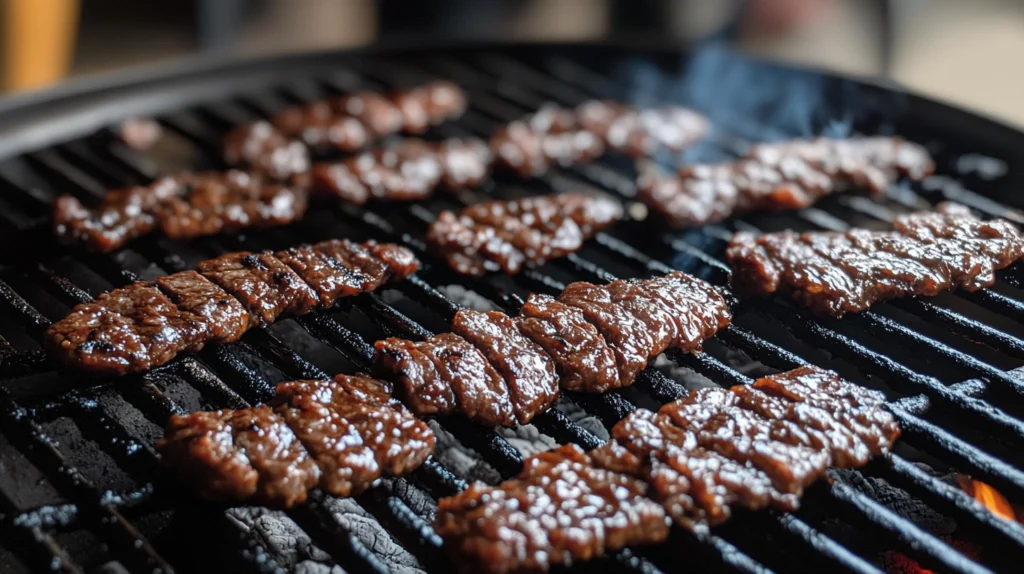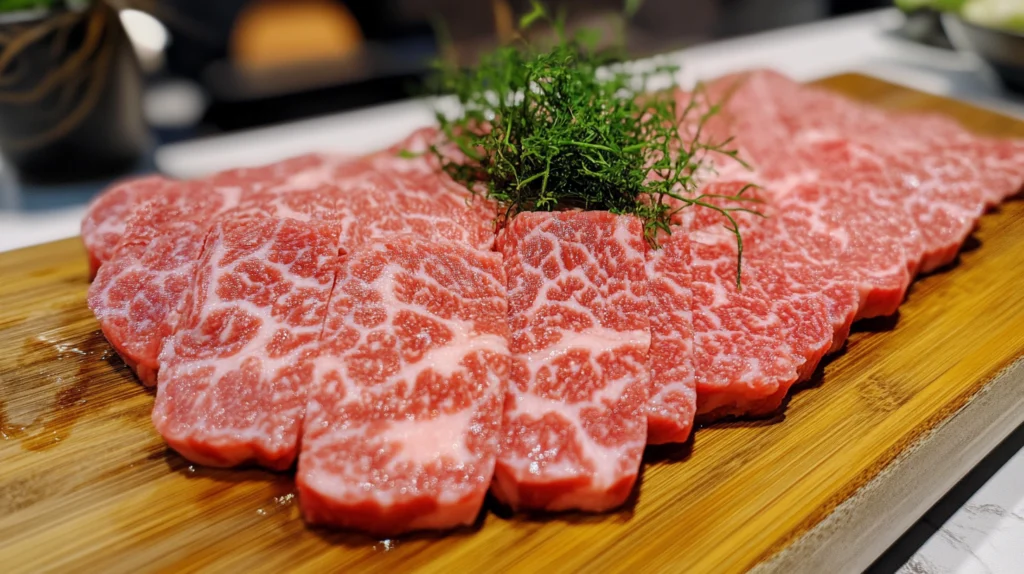Bulgogi, often called Korea’s “fire meat,” is a beloved dish worldwide. Its delicate balance of sweet and savory flavors, combined with tender slices of beef, has made it a go-to favorite for Korean BBQ enthusiasts. However, achieving that melt-in-your-mouth texture can be tricky. Many home cooks find themselves asking, “Why is bulgogi so chewy?”
In this article, we’ll explore the most common reasons bulgogi becomes chewy, from improper meat selection to overcooking. More importantly, we’ll share practical tips and expert advice to ensure your bulgogi is always tender, juicy, and full of flavor. Whether you’re a seasoned chef or trying bulgogi for the first time, this guide will transform your cooking skills.
Understanding Bulgogi and Its Popularity
What is Bulgogi?
Bulgogi, which translates to “fire meat,” is a traditional Korean dish made from thinly sliced beef or pork, marinated in a blend of soy sauce, sugar, sesame oil, garlic, and other seasonings. This marinade gives bulgogi its signature sweet and savory flavor. It’s often grilled over an open flame, pan-fried, or broiled, making it a versatile dish that can be enjoyed in various settings—from casual family dinners to festive Korean BBQ gatherings.
The appeal of bulgogi lies not only in its taste but also in its simplicity. It’s easy to prepare, requires minimal ingredients, and offers a unique cultural experience. However, the texture of the meat plays a crucial role in the dish’s overall enjoyment. A perfect bulgogi bite should be tender and juicy, with just the right amount of caramelization.
Why Texture Matters in Korean BBQ?
In Korean cuisine, texture is as important as flavor. Bulgogi, in particular, is celebrated for its soft, almost buttery texture that contrasts beautifully with the charred edges from grilling. When bulgogi turns out chewy, it can ruin the dining experience, leaving diners disappointed.
Chewy bulgogi often results from mistakes in preparation, such as improper marination or overcooking. While some might blame the quality of the meat, the truth is that even a great cut of beef can turn tough without proper handling.
Fun Fact: In traditional Korean BBQ culture, bulgogi is typically paired with side dishes like kimchi, pickled radishes, and lettuce wraps, which enhance the overall texture and flavor profile of the meal.

Common Reasons for Chewy Bulgogi
1. Overcooking the Meat
One of the most common culprits behind chewy bulgogi is overcooking. Thin slices of meat cook quickly, and leaving them on the heat for too long can cause the proteins to tighten and lose moisture, resulting in a tough texture. Since bulgogi is usually sliced thinly to allow for faster cooking, it’s crucial to monitor the cooking time carefully.
Pro Tip: Cook bulgogi on high heat for a short period to achieve a caramelized exterior while keeping the interior juicy and tender.
2. Using the Wrong Cut of Beef
Bulgogi is traditionally made with tender cuts of beef such as ribeye, sirloin, or tenderloin. Using tougher cuts like chuck or brisket can lead to a chewy result, even with proper preparation. Marbling, or the fat content within the meat, also plays a significant role in achieving that melt-in-your-mouth texture.
If you’re unsure about which cut to choose, ask your butcher for advice. High-quality, well-marbled beef is ideal for bulgogi, as the fat helps keep the meat moist during cooking.
3. Improper Marination Techniques
The marinade is a key element in bulgogi preparation. A good marinade not only infuses the meat with flavor but also tenderizes it. Skipping key ingredients like pear or kiwi, which contain natural enzymes, can result in less tender meat. Additionally, marinating the meat for too short a time might not allow the flavors to penetrate deeply, leading to uneven cooking and chewy bites.
Common Mistakes:
- Not fully coating the meat in the marinade.
- Using too little marinade for the amount of beef.
- Skipping acidic or enzymatic components, such as fruit puree or vinegar, that help break down tough fibers.
4. Slicing the Meat Incorrectly
Thin slicing is a hallmark of bulgogi preparation, but how the meat is sliced is equally important. Cutting against the grain shortens the muscle fibers, making the meat easier to chew. Slicing with the grain, on the other hand, leaves long fibers intact, which can make the meat feel rubbery.
How to Prevent Chewy Bulgogi?
1. Choosing the Right Meat Cuts
To achieve tender bulgogi, start with the right cut of meat. Opt for cuts that are naturally tender and well-marbled, such as:
For better insights into meat choices, explore what kind of meat is used for bulgogi.
- Ribeye: Known for its rich marbling and buttery texture.
- Sirloin: A leaner option that still delivers tenderness.
- Tenderloin: Extremely tender but more expensive.
When possible, avoid tougher cuts like brisket or flank steak unless you plan to use advanced tenderizing techniques, as these cuts can result in chewy bulgogi.
Tip: If you’re on a budget, you can use less expensive cuts but tenderize them with marinade or mechanical tools like a mallet.
2. Tips for Marinating Bulgogi
Marination is the secret weapon for tender bulgogi. A well-balanced marinade not only flavors the meat but also helps break down tough fibers. Follow these tips for success:
Learn more about the perfect balance of flavors in what is bulgogi sauce made of.
- Include natural tenderizers: Add fruits like Korean pear, kiwi, or pineapple to the marinade. These contain enzymes that help soften the meat. Be careful not to overuse these ingredients, as they can make the meat mushy.
- Let it rest: Marinate the beef for at least 4 hours or overnight in the refrigerator to allow the flavors to deeply penetrate the meat.
- Balance the flavors: Combine salty (soy sauce), sweet (sugar or honey), and umami-rich (sesame oil and garlic) ingredients for a harmonious taste.
3. Cooking Bulgogi at the Right Temperature
Cooking bulgogi requires precise heat control to avoid overcooking. Follow these guidelines for the best results:
- High Heat: Use high heat to sear the meat quickly. This locks in juices and creates the signature caramelized flavor.
- Quick Cooking Time: Bulgogi cooks in minutes, so keep a close eye to avoid drying it out.
- Use Non-Stick Surfaces: If cooking on a stovetop, use a non-stick pan or griddle to prevent sticking and ensure even cooking.
4. Avoid Overcrowding the Pan or Grill
When cooking bulgogi, always avoid overcrowding. Overloading the pan or grill can cause the meat to steam rather than sear, resulting in a rubbery texture. Cook in small batches if necessary to maintain the proper cooking environment.

Expert Tips for Tender Bulgogi
1. The Role of Slicing Techniques
Slicing the beef correctly is crucial for tender bulgogi. Always slice the meat:
For an alternate twist, try experimenting with ground beef bulgogi for a unique approach to this classic dish.
- Against the Grain: This shortens the muscle fibers, making the meat easier to chew.
- Thinly: Aim for slices that are around 1/8-inch thick. Thinner slices cook faster and more evenly.
If you struggle to cut the meat thinly, freeze it for about 30 minutes before slicing. This firms up the beef, making it easier to achieve precise cuts.
2. Using a Meat Tenderizer
A meat tenderizer, like a mallet or blade tenderizer, can help soften tougher cuts of beef. Gently pound the meat to break down connective tissue without completely flattening it. This method is particularly useful if you’re using less expensive cuts of beef.
Pro Tip: Avoid over-tenderizing, as it can change the texture and make the meat fall apart during cooking.
3. Resting the Meat Before Cooking
Resting the meat after slicing and marinating allows the flavors to meld and the enzymes in the marinade to work their magic. This step also helps the meat relax, preventing it from tightening up when exposed to high heat.
4. Adding a Final Glaze
For added tenderness and flavor, brush the cooked bulgogi with a thin layer of marinade during the final moments of cooking. This creates a glossy finish and enhances moisture.
Frequently Asked Questions and Conclusion
Frequently Asked Questions (FAQs)
1. Why does bulgogi sometimes turn out tough?
Bulgogi becomes tough due to overcooking, using the wrong cut of meat, or improper marination. Thin slices of beef cook very quickly, so even a minute of extra heat can dry them out. Additionally, tough cuts of beef or insufficient marinating time can leave the meat chewy.
2. What cuts of beef are best for bulgogi?
The best cuts for bulgogi are ribeye, sirloin, and tenderloin because they are tender and well-marbled. These cuts cook quickly and retain their juiciness. If using tougher cuts like flank or chuck, marinate them longer or use a tenderizer to improve the texture.
3. Can I fix chewy bulgogi?
Yes, there are a few ways to salvage chewy bulgogi:
- Sauté the cooked meat in a small amount of marinade or broth to rehydrate it.
- Slice the meat thinner and serve it in dishes like rice bowls or stir-fries to mask the toughness.
4. How long should I marinate bulgogi?
For the best results, marinate bulgogi for at least 4 hours. For maximum flavor and tenderness, marinate the meat overnight in the refrigerator. Avoid marinating for longer than 24 hours to prevent the meat from becoming overly soft or mushy.
5. Can I use pork for bulgogi?
Yes, pork bulgogi is a popular variation of the dish. Use cuts like pork shoulder or pork belly, and adjust the marinade slightly by adding more spice or sweetness to complement the flavor of pork.
6. What’s the ideal way to cook bulgogi at home?
For a smoky, authentic flavor, cook bulgogi on a grill. If a grill isn’t available, a stovetop griddle or a cast-iron skillet works well. Ensure the heat is high and the meat is cooked quickly in small batches for optimal caramelization.
Conclusion
Bulgogi is a masterpiece of Korean cuisine, celebrated for its rich flavors and tender texture. However, achieving the perfect bite requires attention to detail in every step of preparation, from selecting the right cut of beef to slicing it correctly and marinating it thoroughly.
Discover ideas for what to serve with ground beef bulgogi to make your meal complete.
If your bulgogi turns out chewy, it’s likely due to overcooking, tough cuts of meat, or insufficient marination. But with the tips shared in this guide, you’ll be able to identify and correct these issues, ensuring your bulgogi is tender and delicious every time.
Cooking bulgogi is as much an art as it is a science. Experiment with different marinades, cooking techniques, and cuts of meat to find what works best for you. With practice, you’ll master the dish and delight your family and friends with restaurant-quality Korean BBQ at home.

